I should make this stew more often because it’s one of the few foods that all three of my kids like. It’s delicious, fast, and easy too. Inexplicably, I make it only for religious feasts alongside Puris, Kale Chole, and Sooji Ka Halwa.
Prep time: 10 minutes
Cook time: 25 minutes
Yield: 8 servings
Ingredients
- 2 potatoes, peeled and diced
- 2 tomatoes or 2/3 cup tomato puree
- 1/4 cup plain yogurt
- *small bunch of cilantro, chopped
- *3/4 teaspoon turmeric
- *1 1/2 teaspoon whole cumin seeds
- 2 tablespoons vegetable oil
- *1/2 teaspoon fenugreek leaves, optional
- 4 cups water
- *salt and black pepper to taste
INSTRUCTIONS
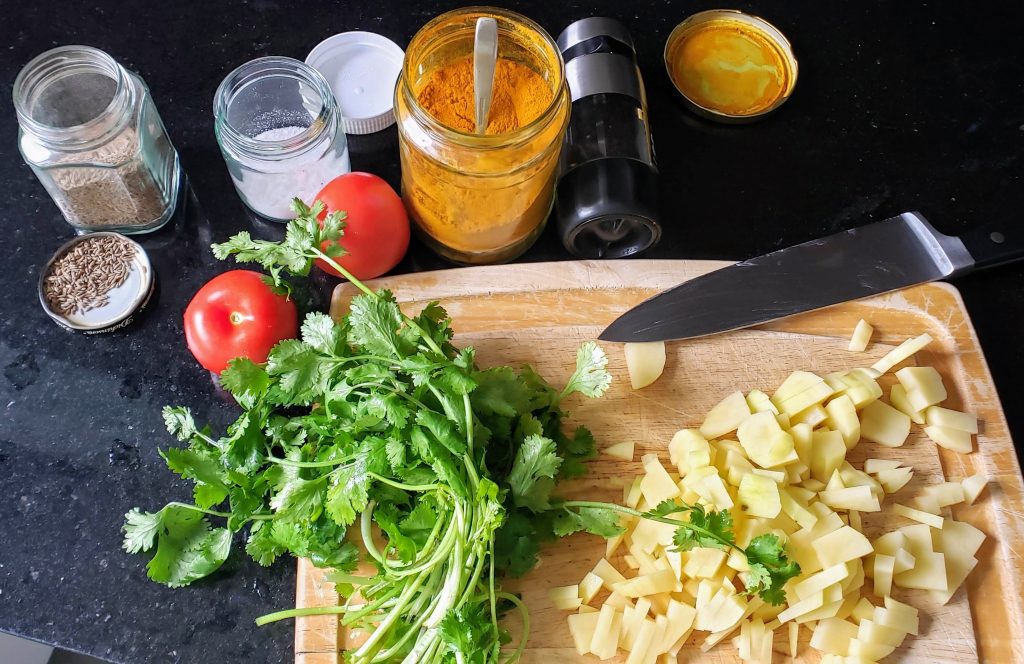
Cumin seeds, salt, turmeric, black pepper, tomatoes, corriander, potatoes
1. Wash, peel and dice potatoes into 1/2-inch cubes.
2. Wash and dice, or grate or puree fresh tomatoes. You can also use tomato puree.
3. Set a pressure cooker to medium/high heat. You can use a pot to do this, but it will take longer to soften the potatoes. Add the oil and cumin seeds.
4. When the seeds start to sizzle, add the turmeric powder, stir and cook for 5 seconds.
5. Add the diced potatoes and mix well to coat. Add the crushed fenugreek leaves.

Cumin in oil 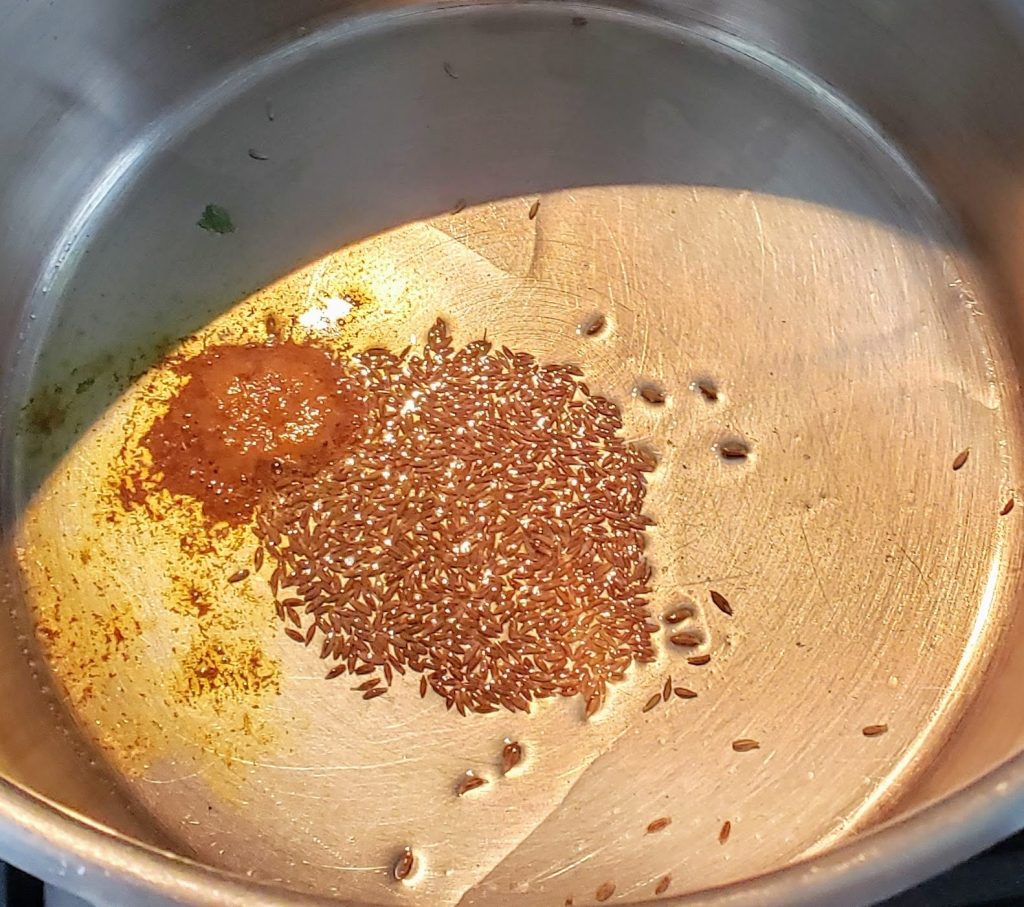
Addition of Turmeric 
Add potatoes and fenugreek
6. Add the tomatoes and salt and let cook until the tomatoes release their liquid and darken. Don’t worry if they stick a little, keep stirring.
7. Add the yogurt and cook until the yogurt releases its oil. It’ll take 3-5 minutes.
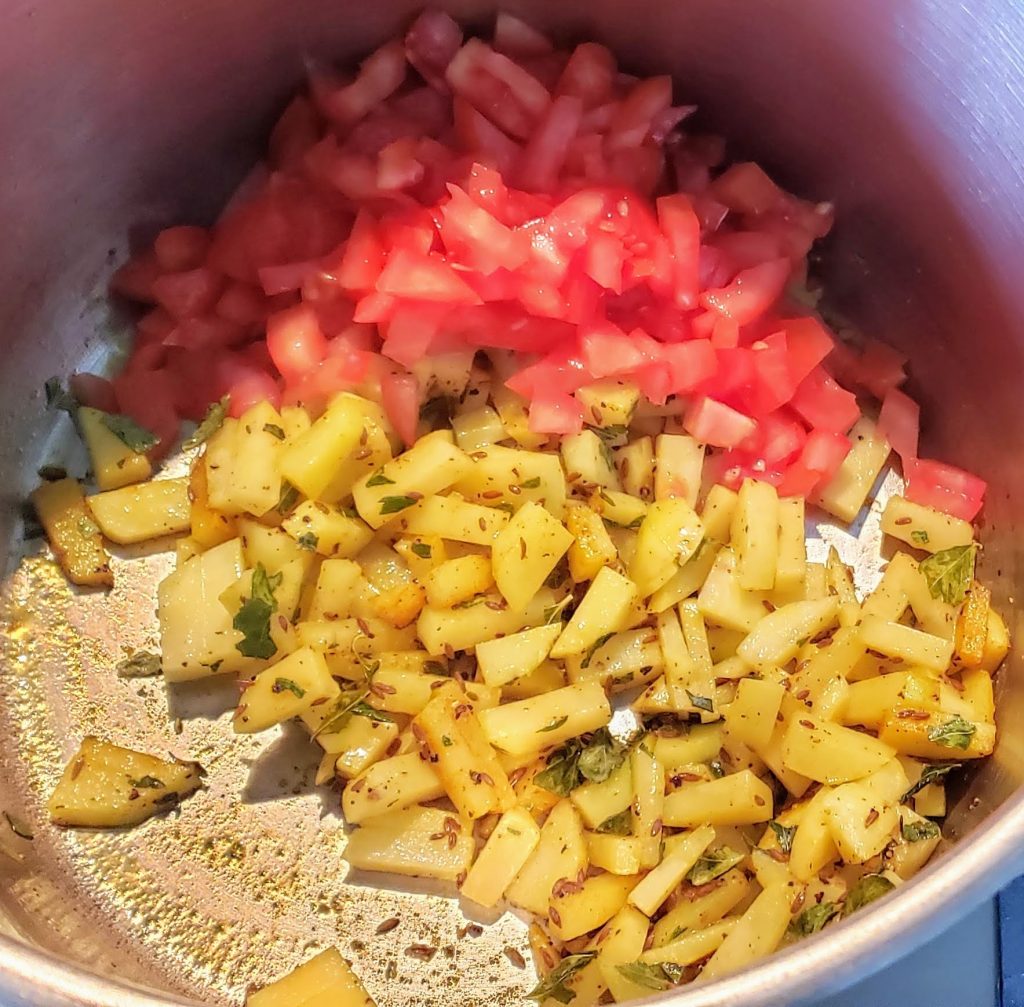
Add tomatoes 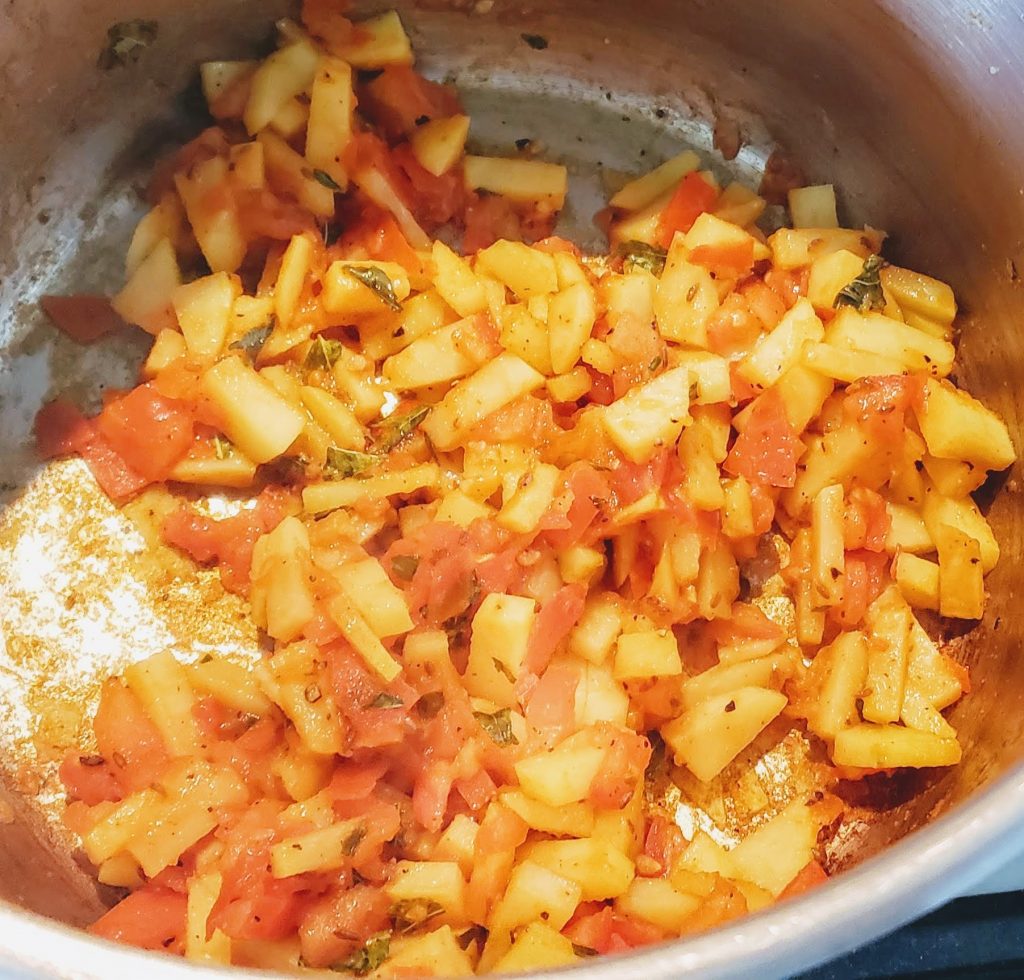
Cook until tomatoes release color 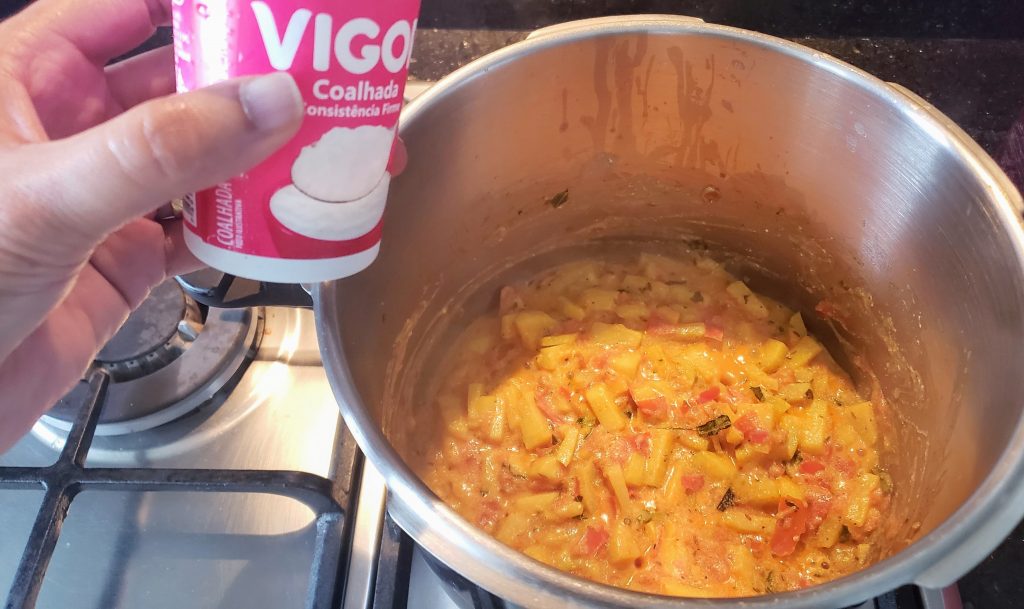
Add yogurt
8. Add the water and stir to ensure nothing is sticking. Add the chopped cilantro and black pepper. Cover, and set to pressure cook.
9. If using a pressure cooker, cook it for 20 minutes. If you are using a covered pot, it’ll take about 45-50 minutes to soften the diced potatoes.
10. After the appropriate cooking time has elapsed, open the vessel, and mash some of the potatoes gently with a potato masher or the back of a wooden spoon to thicken the gravy.
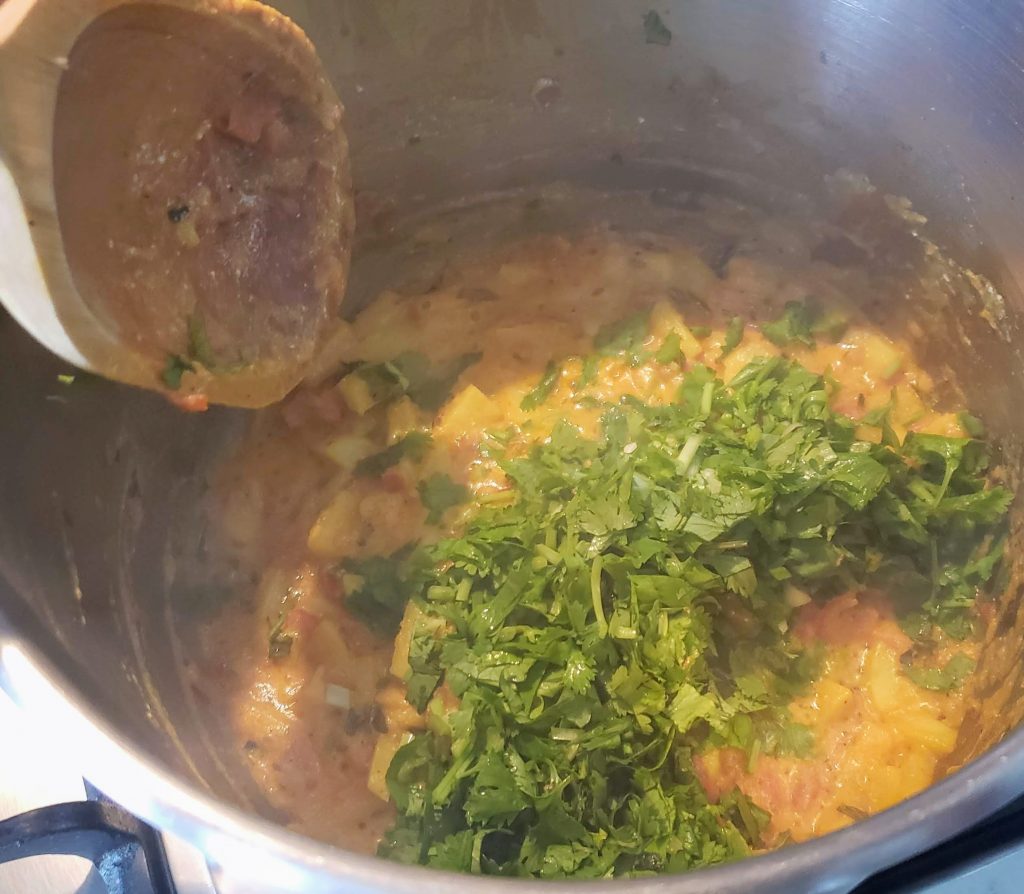
Add cilantro 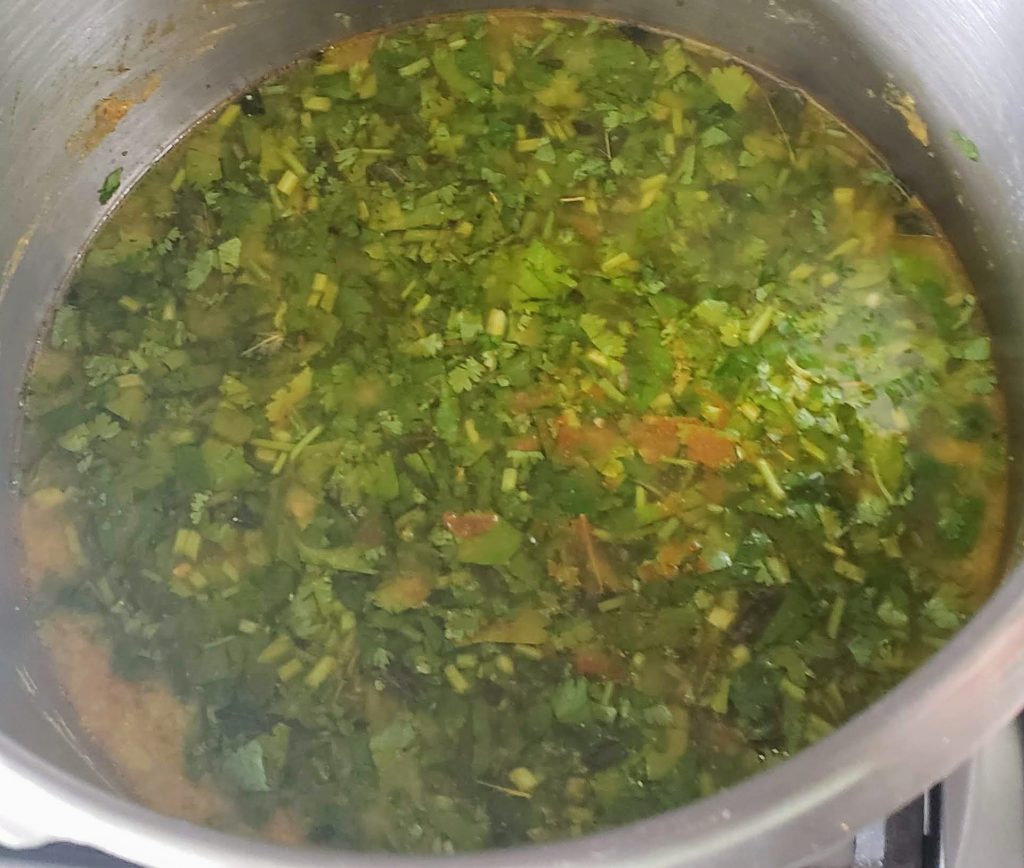
Add water and black pepper 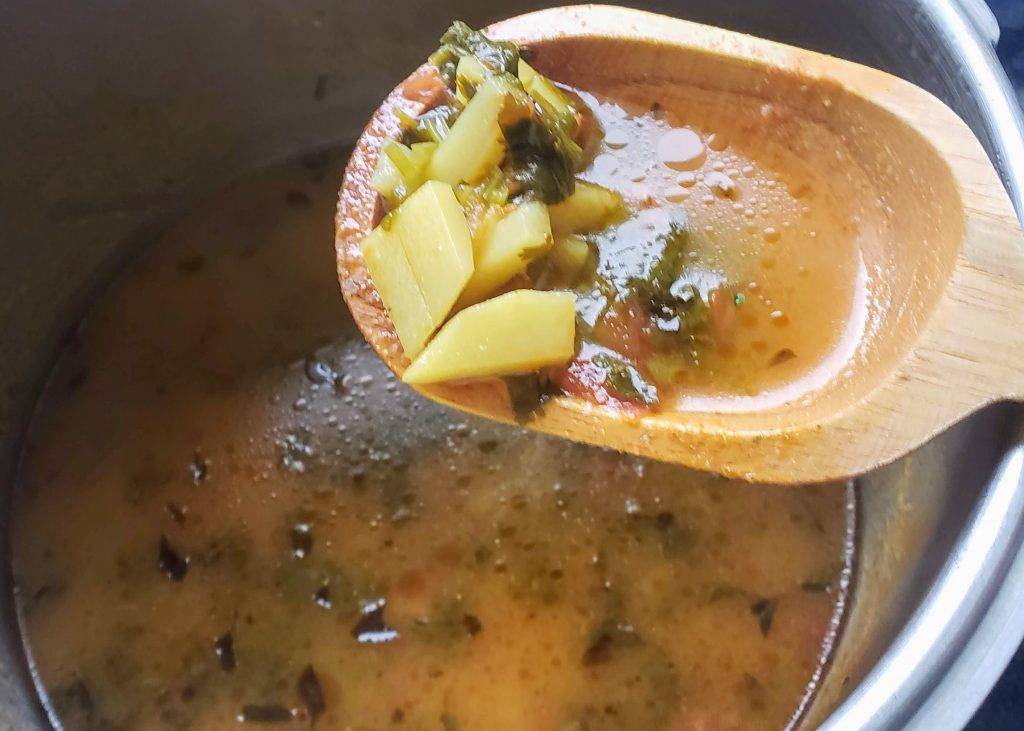
Finished product
11. Serve hot with Puris.
Note:*These ingredients may be purchased at your local Indian grocer. For this reason, I have given you the name of the spice both in English and Hindi as that is the name (written phonetically in the English alphabet) you will find it under when you go shopping.
Spices impart specific flavors and aromas that enhance the overall flavor of the dish when used correctly. Moreover, they have a lot of health benefits. The list below specifies:
- The name of the spice;
- The flavor(s) it imparts;
- How and when it may be used; and, finally,
- It’s health benefits.
Dhania (fresh coriander) – Citrus-like, Soapy. Either you’ll love it or hate it. Both leaves and stems are used as a condiment and added to food at the end of cooking as decoration, an aromatic and a flavor enhancer. It is used all over Asia and in Latin America. It is made into chutneys and salsas. It is chopped and added to salads. It is baked as part of stuffing into bread such as parathas. It is added to vegetarian and meat dishes alike. Coriander may protect your heart by lowering blood pressure and LDL (bad) cholesterol while increasing HDL (good) cholesterol. It is an antimicrobial, antioxidant and reduces the symptoms of Irritable Bowel Syndrome such as bloating or gas.
Haldi (turmeric powder) – Bitter and earthy. Turmeric is added to the oil after all the other spices during the cooking process. Used in powder form or the fresh, grated or minced form to season vegetable and meat dishes. Made into a pickle and eaten fresh. Boiled using fresh minced or powdered into a Tisane. Powdered form mixed with yogurt and black pepper and consumed. Added in powdered form to milk and consumed to combat sickness like cold/flu/throat ache or help reduce swelling in the body. Mixed with oil (coconut or any neutral tasting oil) into a paste as a wound dressing to prevent infection and reduce swelling; or, rubbed onto the face as a skin cleanser. The main active ingredient is curcumin. CURCUMIN IS POORLY ABSORBED BY THE BODY AND MUST BE CONSUMED WITH BLACK PEPPER TO INCREASE ITS ABSORPTION BY 2000%. If you are using a turmeric supplement, make sure it contains piperine (BioPerine) to help with curcumin absorption, otherwise, the curcumin will just pass through your body and not be absorbed. Curcumin is fat-soluble, so it is good to eat turmeric with a fatty meal. Curcumin is a powerful anti-inflammatory and anti-oxidant. Fights Alzheimer’s and depression by increasing a growth hormone (BDNF) that increases the growth of new neurons. It helps minimize the risk of heart disease. It helps fight cancer.
Jeera/Geera (cumin seeds) – Earthy, smoky. The whole form is added as one of the first spices when seasoning cooking oil. If using it in the powdered form to season cooked food, add it after the burner has been turned off. Used whole when flavoring cooking oil in vegetarian and meat dishes. The whole form is added as one of the first spices when seasoning cooking oil. Used as a powder either by itself or as part of Garam Masala after cooking for both vegetarian and meat dishes. Whole seeds are boiled in water to make a tisane to aid digestion (reduces gas), for weight loss, and relaxation. Rich in iron – it has 66g of iron per 100g which is five times the daily dose. Aids in digestion; improves blood cholesterol; promotes weight loss and fat reduction; and, helps promote sleep. It also helps with diabetes. It has both stimulating and calming effects. Improves cognitive function and helps prevent cognitive disorders such as dementia and Alzheimers. It also improves lactation.
Kali Mirch (black pepper) – Sharp, spicy. Whole peppercorns can be added early on when using them to season cooking oil. However, the ground form is only used toward the end of cooking. Black pepper is used as a condiment and a food preservative. It is one of the components of Garam Masala and Chaat Masala. It is used whole to season doughs like Mathi (savory crip wafer). It is most often ground and used as a condiment in cooked foods. The ground form, when mixed with honey is used to relieve coughs and sore throats and improve breathing. Whole peppercorns are brewed into a tisane to effect the same benefits. For best results, don’t buy it preground as you’ll lose not only flavor but also many health benefits. BLACK PEPPER INCREASES THE BIOAVAILABILITY of certain other nutrients, especially, but not limited to CURCUMIN, WHICH IS THE ACTIVE INGREDIENT OF TURMERIC. It helps reduce swelling; it is a known antibacterial; it’s an anti-inflammatory; and, is high in antioxidants. It is a natural pain killer. In ancient times, it was used in conjunction with salt to preserve meat. It helps drain the sinuses.
Sooki Methi (dried, crushed fenugreek leaves) – Earthy, bitter. Whole seeds are used to season oil but should be added late as they are bitter. Toasted, crushed leaves are used to season food after turning the burner off. Toasted, crushed leaves are used as a condiment for gravies after cooking either meats or vegetables. Toasted, crushed leaves are added as a seasoning for bread dough and Mathi dough. Fresh fenugreek leaves make a delicious vegetable dish when added to potatoes. It promotes lactation for breastfeeding mothers; it reduces the symptoms of menopause; reduces menstrual comfort; lowers cholesterol; controls diabetes; and, is an appetite suppressant. If you plant the seeds, you’ll get fresh fenugreek.
Written by Anju Kapur of Anju’s Table. All content and images on this site are copyright protected. Please do not use any of my images without my permission. Should you wish to share this recipe on your site, please add a link to this post as the source.

[…] wheat bread), Sooji Ka Halwa (sweet farina porridge), Kale Chole (savory black chickpeas), and Aloo (potato […]